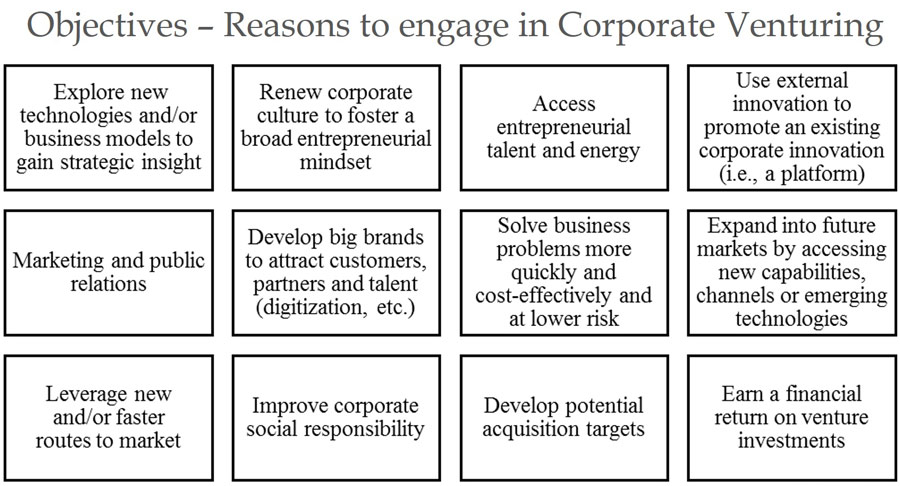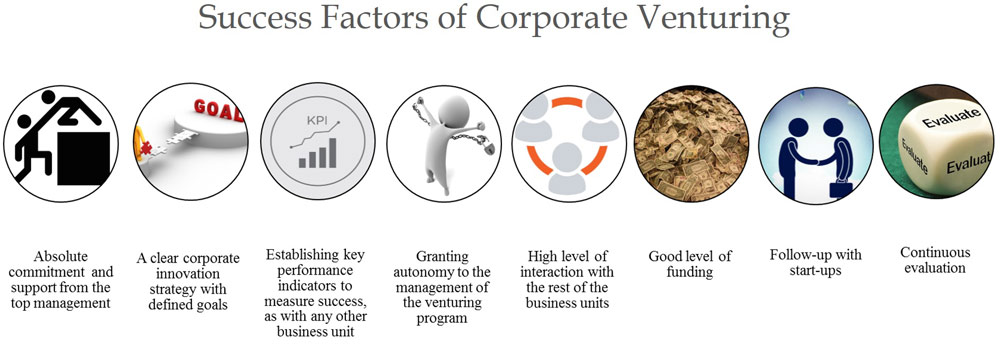What is the process to set up a venturing strategy?
A. Set Out the Objectives
Corporations must stress out what impact they want to have in the long run before interacting with startups. Deciding the strategic intent early on will not only help corporations to design an effective overall innovation strategy but also save time. Sometimes companies start working with a sample of startups before they have a clear strategy and soon the collaboration ends up being a waste of time and resources for both parties. In these cases, it is highly recommended to establish a standardized decision-making timeline that will determine whether or not collaborations proceed, to avoid losing time in months of pitches or meetings without any outcome.
In other cases, companies just look for the financial return of a quick sale. It is also common to find corporations engaged in corporate venturing merely for public relations or corporate social responsibility purposes. However, our research has shed light on the extraordinary benefits that corporate venturing can have as a long-term strategy embedded in the core of corporations that intend to be truly innovative.
The first step a company that is considering exploring corporate venturing should make is to define a long-term strategy with a clear set of objectives. Among the objectives, the digital transformation of the company is commonly found to be an important driver.
Others include opening new pathways to better solutions, expanding into new markets, rejuvenating the culture with entrepreneurial talent and transforming the corporate image. These are just a sample of the reasons why corporations engage in collaboration but each company can have its own. Ultimately, the venturing strategy that is designed will help companies choose certain tools over others in order to achieve a better outcome with their particular goals, whatever those may be.
The most important reasons why corporations engage in corporate venturing are:
It is possible that a company may be looking to achieve only one objective while others may be looking to achieve several. Management must define the company’s objectives and intelligently stick to them throughout the implementation of the innovation strategy to double-check whether or not they are achieving the aims for which the strategy was designed.
B. Build a Venturing Strategy
Once the goal has been clearly identified, the next step is the creation of a venturing strategy consistent with the objectives:
Whether a corporation is considering launching a venturing strategy as part of its innovation efforts for the first time or whether it has launched venturing programs already in the past, it is important to analyze the recommendations for a successful outcome from corporations that have been through this experience already.
It is important to be aware beforehand of the great importance of working with a critical mass of startups. This knowledge can mean the difference between failing and having mediocre or brilliant results. Corporations must be able to attract a high number of startups to their venturing strategies to cherry-pick the best ones. This should be given priority from day 1 to give traction to the strategy.
C. Define the Organizational Structure and Resources
Another recurring doubt is where the venturing strategy or units fit best within a company’s organizational structure. This varies enormously from one company to another and there is no correct answer that can apply to all companies. Just the opposite – each corporation decides on what fits best according to its own organization, culture and tradition.
A research study involving 112 corporations from different sectors, conducted by Imaginatik and MassChallenge in 2016, showed that 29% of corporations chose to assign the responsibility for managing startup interactions to the innovation function, most having been created within the previous five years. However, although corporate innovation is the function that most often manages corporate venturing activities, other companies have chosen R&D (13%), technology (12%), strategy (12%), business lines/P&Ls (12%), the executive team/board (11%), corporate development (8%), marketing (4%), corporate social responsibility (4%) and others (1%).
However, according to our research, this function is moved along the structure depending on the stage of the initiative across Departments. Sometimes there is a mixture or a vaguely defined management of activities, with other departments having existing startup relationships of their own.
Finally, the following figure summarizes the most important elements to consider during both the design and implementation of the strategy:
The first factor is that the firm’s top management should buy into the idea of making collaboration with startups an embedded part of the company’s strategy. This includes ensuring that this commitment is communicated downward effectively, creating the right organizational context, educating people about the benefits of innovation and the risks associated with sticking to the status quo, and training the people who are most directly involved. Consensus built on a common purpose will help everybody pull in the same direction. If there is still only a minority that supports it, it is interesting to start off with a small-scale pilot program focused on a topic of widespread interest, iterate and then scale up.
At the same time, venturing units must be granted freedom to work independently and take their own decisions, always in accordance with their goal and overall strategy. Knowing where is the company heading to, why and how is critical. In other words, having a clear corporate innovation strategy with defined goals. The venturing strategy should be continuously evaluated, and establishing KPI’s for the venturing units will allow its measurement and performance analysis, just like any other business unit with which, by the way, should be able to interact fluently. The interaction with the rest of the business units should be a result of mutual trust and support, as well as with startups, with whom there should be a follow-up after the venturing tool or program is finished. Finally, a lack of resources should not be an obstacle.
As a whole, the venturing strategy must be a gear with incentive structures that can maximize results and get startups rapidly through the cycle. Continuous testing of the strategy and approach that a company has adopted is necessary. Beyond a clear objective of what a company is trying to achieve internally and externally and how it plans to achieve this, there must be an unceasing comparison between the strategy, the results obtained and the environment of a corporation via screening with metrics to measure success.
For example, a common way is to incorporate entrepreneurship as a key performance indicator to measure the impact of the collaboration in such a way that the people involved within the company must prove they are reaching out to the startup community to gather new ideas or demonstrations of entrepreneurial behavior in the startups’ teams. Although this is something very basic, it is not that easy. Corporations do not usually learn where to find interesting entrepreneurs and how to contact them, so it is important to build a clear strategy.
In our next post, we introduce to you the most important factors to look at for a successful venturing strategy.
Corporate Venturing post series:
- What is Corporate venturing?
- Why Corporations Need to Collaborate With Startups?
- Tips to Lauch a Corporate Venturing Program
- Success Factors of Corporate Venturing
- A Guide of Corporate Venturing: Tools, Descriptions and Features
This posts are based on: Corporate Venturing: Achieving Profitable Growth Through Startups








Thanks for share.